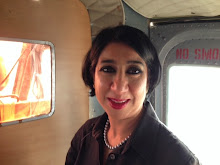This interview appeared first in the
Asian Age's Kolkota version I believe. I have a special relationship with Calcutta, as I like to call it, as my mother Parsan was educated there in an Urdu-speaking school. She still makes Bengali speakers smile as she grew up in that town and also speaks fluent Bengali. I haven't been back there since I was a child- my parents took me out of public school in England, Haberdashers' Aske's, for an extended tour of India to visit friends and relations around the country and I recall a lovely long stay with the Bala family in Calcutta.
While I am grateful for all the newspaper space being afforded me, I am highly intrigued by the way in which my answers are subbed.
My original answer to the Asian Age's first question ran;
1. how did u come to the decision on writing a biography on sonia gandhi. was the idea brewing in your mind since a long time or a particular incident provided you the impetus to write sonia gandhi's biography?
I had been covering Indian politics and quite a few Indian elections. In 2009 I provided the political analysis for Sky News for television and online for the Indian general election. Sonia Gandhi had featured in my work. Palgrave Macmillan in New York City had already decided that they wanted to produce a book on the life of Sonia Gandhi, and they were searching for a suitable writer. They had been reading my work. One day I found an email from them in my Googlemail asking me if I would be interested in writing this challenging book. I was and so I did. It was actually their idea, not mine. Subbed to
Like many foreign reporters looking for newsworthy plots in the heat and dust of India, London- based author Rani Singh’s journalistic pursuits would often bring her to the subcontinent. The 2009 Indian election coverage proved pivotal, as it was during this particular assignment, she managed to have a closer look at Sonia Gandhi, yet little did Rani know that her trail would eventually pave the way for her to write one of the most talked about book on the iconic Gandhi bahu. Talking about how the idea for the book unfolded, the author says, “In 2009, I provided the political analysis for Sky News television for the Indian general election. Sonia Gandhi had featured in my work. Palgrave Macmillan in New York City were keen to publish a book on her life and they were searching for a suitable writer. My work caught their attention and one fine day I received an email enquiring about my views on writing this challenging book. Of course my answer was an instant yes.”
Spot the differences?
I am so grateful to journalists from newspapers and journals who read the book and take the time to construct lengthy interviews for me to answer on email.
Palgrave in New York City has just given me an update on current sales figures which they are monitoring; sales in India alone have already topped 15,000. Buyers would be from among the English non-fiction literature buying public, I am assuming, which is, after all, a fraction of the overall population.

